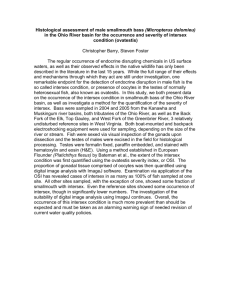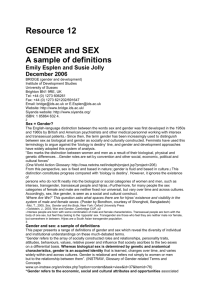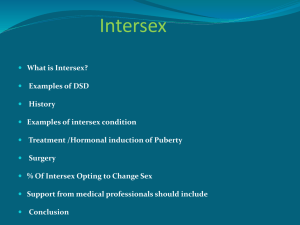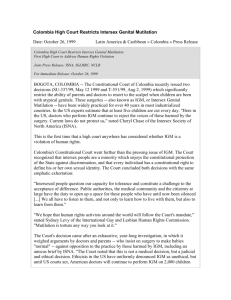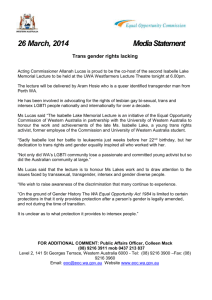intersex - Sociologists for Women in Society
advertisement
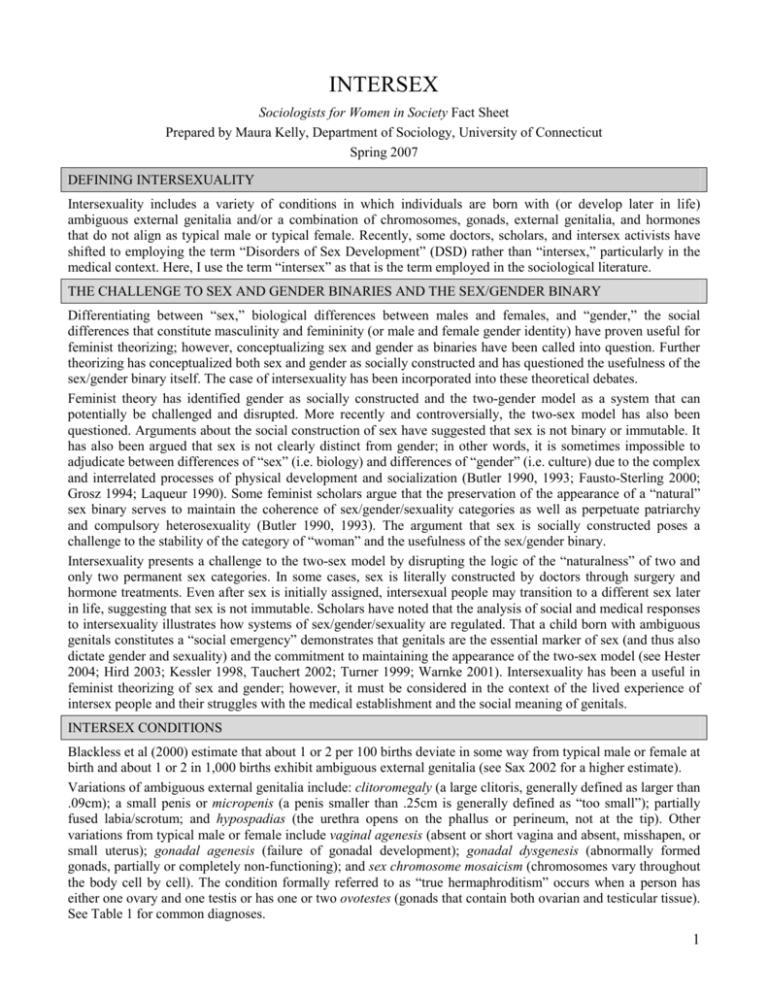
INTERSEX Sociologists for Women in Society Fact Sheet Prepared by Maura Kelly, Department of Sociology, University of Connecticut Spring 2007 DEFINING INTERSEXUALITY Intersexuality includes a variety of conditions in which individuals are born with (or develop later in life) ambiguous external genitalia and/or a combination of chromosomes, gonads, external genitalia, and hormones that do not align as typical male or typical female. Recently, some doctors, scholars, and intersex activists have shifted to employing the term “Disorders of Sex Development” (DSD) rather than “intersex,” particularly in the medical context. Here, I use the term “intersex” as that is the term employed in the sociological literature. THE CHALLENGE TO SEX AND GENDER BINARIES AND THE SEX/GENDER BINARY Differentiating between “sex,” biological differences between males and females, and “gender,” the social differences that constitute masculinity and femininity (or male and female gender identity) have proven useful for feminist theorizing; however, conceptualizing sex and gender as binaries have been called into question. Further theorizing has conceptualized both sex and gender as socially constructed and has questioned the usefulness of the sex/gender binary itself. The case of intersexuality has been incorporated into these theoretical debates. Feminist theory has identified gender as socially constructed and the two-gender model as a system that can potentially be challenged and disrupted. More recently and controversially, the two-sex model has also been questioned. Arguments about the social construction of sex have suggested that sex is not binary or immutable. It has also been argued that sex is not clearly distinct from gender; in other words, it is sometimes impossible to adjudicate between differences of “sex” (i.e. biology) and differences of “gender” (i.e. culture) due to the complex and interrelated processes of physical development and socialization (Butler 1990, 1993; Fausto-Sterling 2000; Grosz 1994; Laqueur 1990). Some feminist scholars argue that the preservation of the appearance of a “natural” sex binary serves to maintain the coherence of sex/gender/sexuality categories as well as perpetuate patriarchy and compulsory heterosexuality (Butler 1990, 1993). The argument that sex is socially constructed poses a challenge to the stability of the category of “woman” and the usefulness of the sex/gender binary. Intersexuality presents a challenge to the two-sex model by disrupting the logic of the “naturalness” of two and only two permanent sex categories. In some cases, sex is literally constructed by doctors through surgery and hormone treatments. Even after sex is initially assigned, intersexual people may transition to a different sex later in life, suggesting that sex is not immutable. Scholars have noted that the analysis of social and medical responses to intersexuality illustrates how systems of sex/gender/sexuality are regulated. That a child born with ambiguous genitals constitutes a “social emergency” demonstrates that genitals are the essential marker of sex (and thus also dictate gender and sexuality) and the commitment to maintaining the appearance of the two-sex model (see Hester 2004; Hird 2003; Kessler 1998, Tauchert 2002; Turner 1999; Warnke 2001). Intersexuality has been a useful in feminist theorizing of sex and gender; however, it must be considered in the context of the lived experience of intersex people and their struggles with the medical establishment and the social meaning of genitals. INTERSEX CONDITIONS Blackless et al (2000) estimate that about 1 or 2 per 100 births deviate in some way from typical male or female at birth and about 1 or 2 in 1,000 births exhibit ambiguous external genitalia (see Sax 2002 for a higher estimate). Variations of ambiguous external genitalia include: clitoromegaly (a large clitoris, generally defined as larger than .09cm); a small penis or micropenis (a penis smaller than .25cm is generally defined as “too small”); partially fused labia/scrotum; and hypospadias (the urethra opens on the phallus or perineum, not at the tip). Other variations from typical male or female include vaginal agenesis (absent or short vagina and absent, misshapen, or small uterus); gonadal agenesis (failure of gonadal development); gonadal dysgenesis (abnormally formed gonads, partially or completely non-functioning); and sex chromosome mosaicism (chromosomes vary throughout the body cell by cell). The condition formally referred to as “true hermaphroditism” occurs when a person has either one ovary and one testis or has one or two ovotestes (gonads that contain both ovarian and testicular tissue). See Table 1 for common diagnoses. 1 MEDICAL MANAGEMENT OF INTERSEX CONDITIONS The medical management of intersex is largely based on the theory and practice developed at Johns Hopkins University in the 1950s and is often associated with Dr. John Money. It conceptualizes gender identity as malleable and early surgery as necessary. Although in some cases, genital ambiguity is a sign of an underlying medical condition (such as the salt-wasting form of CAH), in most cases, medical treatment of intersex is socially normalizing (rather than medically necessary). The medical model for treating intersex conditions asserts that males must have an “adequate” penis, generally defined as a penis capable of vaginal penetration and urination while standing. Consequently, most infants with ambiguous genitalia are assigned as females (this excludes XY infants with hypospadias, who often undergo surgeries to move their urethras to the tips of their penises). An infant with a large clitoris who is assigned as female will often undergo socially normalizing surgery to reduce her clitoris. An infant assigned as female with a small or absent vagina may have a vaginoplasty performed, although there is increasing support for waiting until adolescence to perform that type of surgery. An “adequate” vagina is defined as one that is large enough for penetration by a penis. These standards for acceptable genitalia have been critiqued as both heterosexist and phallocentric. Table 1: Common Intersex Diagnoses External Chromosomes Gonads Genitalia Turner's syndrome XO Ovaries (non-functioning) Female Klinefelter's syndrome XXY Testes Male Complete androgen insensitivity syndrome (CAIS) XY Testes Female Partial androgen insensitivity syndrome (PAIS) XY Testes Ambiguous Congenital adrenal hyperplasia (CAH) XX Ovaries Ambiguous 5-alpha-reductase deficiency. XY Testes Ambiguous Note: CAH also affects XY individuals, resulting in early or abnormal sexual development. Sources: Consortium on the Management of Disorders of Sex Differentiation (CMDSD) (2006); Migeon et al (2001) Usual Sex Assignment Female Male Female Either Female Either Intersex activists and scholars critique the current medical model for (1) performing medically unnecessary surgeries; (2) not obtaining the consent of the child (and often pressuring the parents to consent to surgery); (3) causing new physical problems as a result of surgery and hormone treatments; (4) reducing sexual functioning; (5) causing psychological damage as a result of medical practices; and (6) promoting secrecy and failing to be open and honest with patients about their conditions (for a thorough critique of the medical model, see Holmes 2002 and Kessler 1998). Those supporting the current medical model for managing intersex argue that intersex activists represent a small minority of intersexed people, most of whom are satisfied with their treatment; this is an empirical claim that is not supported by research. The model for the medical management of intersex supported by many intersex activists is outlined in the Clinical Guidelines for the Management of Disorders of Sex Development (CMDSD 2006). Key components of the protocol include: (1) using a patient-centered multidisciplinary team; (2) assigning the infant a sex based on all available information (not just the appearance of the genitals); (3) delaying unnecessary medical treatment so that the patient can decide when/if to have normalizing genital surgery or hormone treatments; (4) promoting honesty and openness with the family in order to reduce shame and stigma; and (5) providing the necessary psychosocial support. INTERSEX IDENTITY The majority of people with intersex conditions do not identify as intersexed. The development of an intersexed identity has less to do with an ambiguous external genitalia or a combination of chromosomes, gonads, external genitalia, and hormones that do not align as typical male or female and more to do with the social and medical response to the intersexed body as well as participation in activist and/or support groups. Empirical studies of intersex identity are largely based on intersex activists or those involved in intersex support groups (e.g. Preves 2003). What is known from these studies and published personal accounts is that the experience of being intersexed is often characterized by feelings of isolation, stigma, and shame, brought on by the negative experiences with the medical establishment (Chase and Coventry 1997; Dreger 1999). People claiming an intersexed identity have a wide range of diagnoses and experiences. They include those who have had surgery and those who have not; those who have maintained the sex/gender assigned to them at birth and those who later transitioned; and people who identify as male, female, as well as the small number who identify as both/neither. 2 INTERSEX ACTIVISM Starting in 1987, intersex support and advocacy groups began forming in North America (Preves 2004). However, the beginning of the intersex movement is generally identified as occurring in 1993 when Cheryl Chase wrote a letter to the journal Sciences in response to Anne Fausto Sterling’s article “The Five Sexes.” Chase provided a mailing address for the (then non-existent) Intersex Society of North America (ISNA). Chase received a significant response to the letter and ISNA was formed. Although initially conceptualized as a support group, ISNA soon became an advocacy group aimed at changing both medical practices and the stigma associated with intersexuality. In 1996, ISNA held its first intersex retreat and started the ISNA website (www.isna.org). In October 1996, ISNA members picketed the American Academy of Pediatrics (AAP) in Boston due to the AAP’s position on intersex management and their refusal to let intersex people speak for themselves. The intersex movement has been quite successful in using media in its activism and has been covered in gay, independent, and mainstream media. In 1997, it was revealed that one of Dr. Money’s patients, David Reimer (known as John/Joan), a boy who had lost his penis in a botched circumcision, was not satisfied with Money’s initial assignment as a female (as Money had claimed) and later transitioned to become a male. This case received a great deal of media coverage, drawing further attention to the intersex movement (Preves 2004). During its existence, ISNA has made a significant change in tactics, from posing a radical critique of medical practices to working within the medical establishment to change the standards of treatment for intersexed people. Tensions within the movement include disagreement about forming coalitions with the medical community and with the GLBT groups. Intersex activists have engaged in a strategy that employs both essentialist and social constructionist arguments; they have claimed an identity based on bodies that deviate from typical male or female, but at the same time, they argue that genitals should not dictate sex/gender identity (Foster 2004; Turner 1999). The intersex movement has been somewhat successful in changing the medical practices engaged in by some doctors; however, surgery and other medical treatments for intersexed people are still the norm. Going forward, the goals of the intersex movement include supporting intersexed people, educating society about intersex issues, continuing to work toward eliminating the stigma associated with intersexuality, and changing medial practices, with the particular goal of preventing unnecessary surgery on infants and children. EDUCATION, ADVOCACY, AND SUPPORT ORGANIZATIONS Androgen Insensitivity Syndrome Support Group (AISSG) http://www.aissgusa.org Bodies Like Ours http://www.bodieslikeours.org/ Congenital Adrenal Hyperplasia Education & Support (CARES) Foundation http://www.caresfoundation.org Hypospadias and Epispadias Association (HEA) http://www.heainfo.org Intersex Initiative http://intersexinitiative.org/ Intersex Society of North America (ISNA) http://www.isna.org/ The Magic Foundation http://www.magicfoundation.org MRKH Organization http://www.mrkh.org Turner Syndrome Society of the U.S. http://www.turner-syndrome-us.org XY Turner http://www.xyxo.org VIDEOS Chase, Cheryl, director. 1997. Hermaphrodites Speak! 30 minutes. [DVD] Intersex Society of North America. (Available from www.isna.org) Chase, Cheryl, director. 2003. The Child with an Intersex Condition: Total Patient Care. 20 minutes. [DVD]. Intersex Society of North America. (Available from www.isna.org) Cohen, Andrew and Stephen Sweigart, directors. 2001. “Sex: Unknown” NOVA. 60 minutes. [television program]. PBS. October 30 (Available from http://shop.wgbh.org/) Phyllis, Ward, director. 2000. Is it a Boy or a Girl? 60 minutes. [television program]. Discovery Channel. March 26. (Available from www.isna.org) Thomas, Antony, director. 2005. Middle Sexes: Redefining He and She. 60 minutes [television program]. HBO. December 6. (Available from http://store.hbo.com) 3 TEACHING ABOUT INTERSEXUALITY AND INTERSEXED PEOPLE A guide for teaching is offered by the ISNA via their website. Koyama (2003) and Koyama and Weasel (2002) provide excellent advice for teaching about intersexuality and intersexed people. REFERENCES Blackless, Melanie, Anthony Charuvastra, Amanda Derryck, Anne Fausto-Sterling, Karl Lauzanne, and Ellen Lee. 2000. "How Sexually Dimorphic are We? Review and Synthesis." American Journal of Human Biology 12:151-166. Butler, Judith. 1990. Gender Trouble. New York: Routledge —. 1993. Bodies That Matter. New York: Routledge. Chase, Cheryl, Martha Coventry, guest editors. 1997. "Special Issue on Intersexuality." Chrysalis: The Journal of Transgressive Gender Identities 2(5):1-58. Colapinto, John. 2000. As Nature Made Him: The Boy Who Was Raised as a Girl. Toronto: HarperCollins. Consortium on the Management of Disorders of Sex Differentiation (CMDSD). 2006. Clinical Guidelines for the Management of Disorders of Sex Development. (http://www.dsdguidelines.org/files/clinical.pdf) Diamond, Milton, and Keith Sigmundson. 1997a. “Sex Reassignment at Birth: Long-term Review and Clinical Implications.” Archives of Pediatric and Adolescent Medicine 150:298-304. —. 1997b. “Management of Intersexuality: Guidelines for Dealing with Persons with Ambiguous Genitalia.” Archives of Pediatric Adolescent Medicine 151:1046– 1050. Dreger, Alice Domurat. 1998. Hermaphrodites and the Medical Invention of Sex. Cambridge, MA: Harvard University Press. —. 1999. Intersex in the Age of Ethics. Hagerstown, MD: University Pub. Group. Fausto-Sterling, Anne. 1993. "The Five Sexes." Sciences 33:20. —. 2000. "The Five Sexes, Revisited." Sciences 40:18. —. 2000. Sexing the Body: Gender Politics and the Construction of Sexuality. New York: Basic Books. Foster, Johanna E. 2004. "Strategic Ambiguity Meets Strategic Essentialism: Multiracial, Intersex, and Disability Rights Activism and the Paradoxes of Identity Politics." Research in Political Sociology 13:139-178. Gilbert, Ruth. 2002. Early Modern Hermaphrodites: Sex and Other Stories. New York: Palgrave. Grosz, Elizabeth. 1994. Volatile bodies: Toward a Corporeal Feminism. Bloomington, IN: Indiana University Press. Hester, J. David. 2004. " Intersexes and the End of Gender: Corporeal Ethics and Postgender Bodies." Journal of Gender Studies 13:215-225. Hird, Myra J. 2000. "Gender's Nature: Intersexuality, Transsexualism and the ‘Sex/Gender’ Binary." Feminist Theory 1:347-364. Holmes, Morgan. 2002. "Rethinking the Meaning and Management of Intersexuality." Sexualities 5:159180. Koyama, Emi. 2003. Teaching Intersex Issues. Portland, OR: Confluere Publications. (http://eminism.org/store/pdf-zn/ipdx-teacher.pdf) Koyama, Emi and Lisa Weasel. 2002. “From Social Construction to Social Justice: Transforming How We Teach About Intersexuality.” Women’s Studies Quarterly. Kessler, Suzanne J. 1998. Lessons from the Intersexed. New Brunswick, NJ: Rutgers University Press. Laqueur, Thomas Walter. 1990. Making Sex: Body and Gender from the Greeks to Freud. Cambridge, MA: Harvard University Press. Migeon, Claude J., Amy B. Wisniewski, and John P. Gearhart. 2001. “Syndromes of Abnormal Sex Differentiation: A guide for patients and their families.” The Johns Hopkins Children's Center. (http://www.hopkinschildrens.org/specialties/categor ypages/intersex) Preves, Sharon E. 2004. "Out of the O.R. and into the Streets: Exploring the Impact of Intersex Media Activism." Research in Political Sociology 13:179223. —. 2003. Intersex and Identity: The Contested Self. New Brunswick, N.J.: Rutgers University Press. Sax, Leonard. 2002. “How Common is Intersex? A Response to Anne Fausto-Sterling.” Journal of Sex Research 39:174-178. Sytsma, Sharon E. 2006. Ethics and Intersex. Dordrecht, Netherlands: Springer. Tauchert, Ashley. 2002. "Fuzzy gender: Between female-embodiment and intersex." Journal of Gender Studies. Turner, Stephanie S. 1999. "Intersex Identities: Locating New Intersections of Sex and Gender." Gender and Society 13:457-479. Warnke, Georgia. 2001. "Intersexuality and the Categories of Sex." Hypathia 16:126-37. 4
